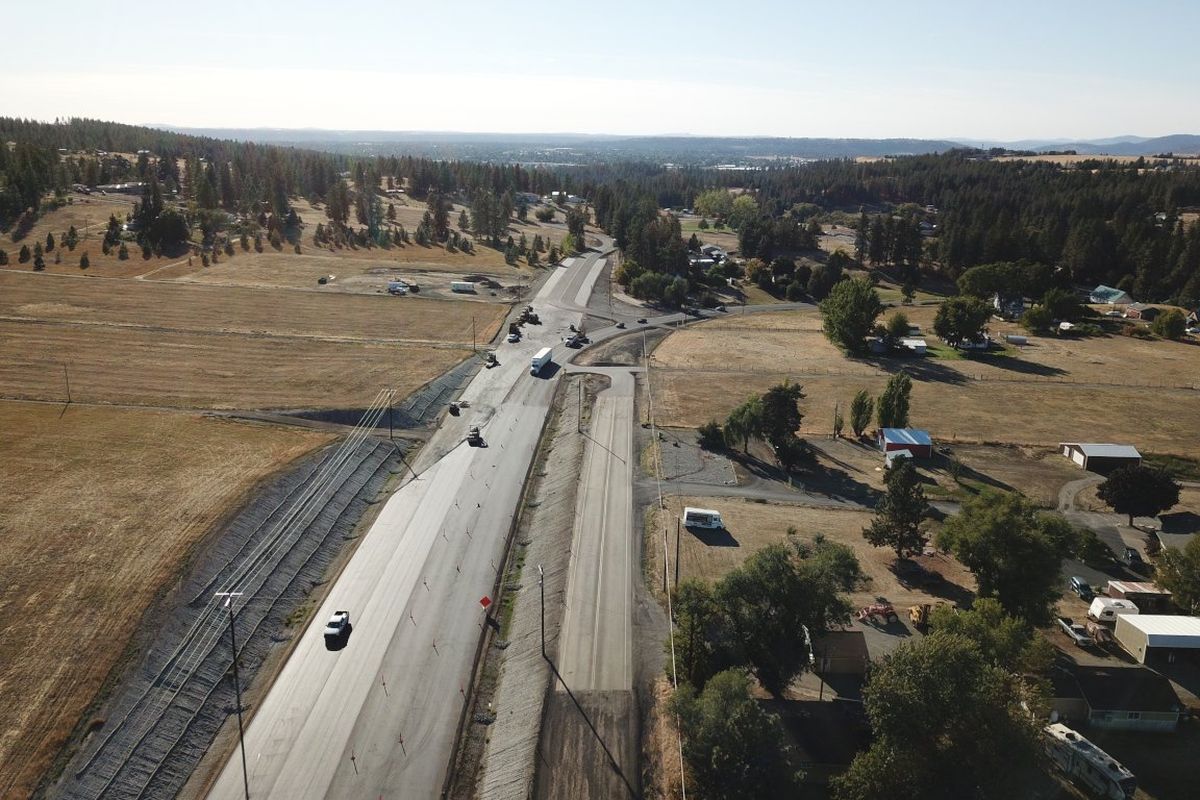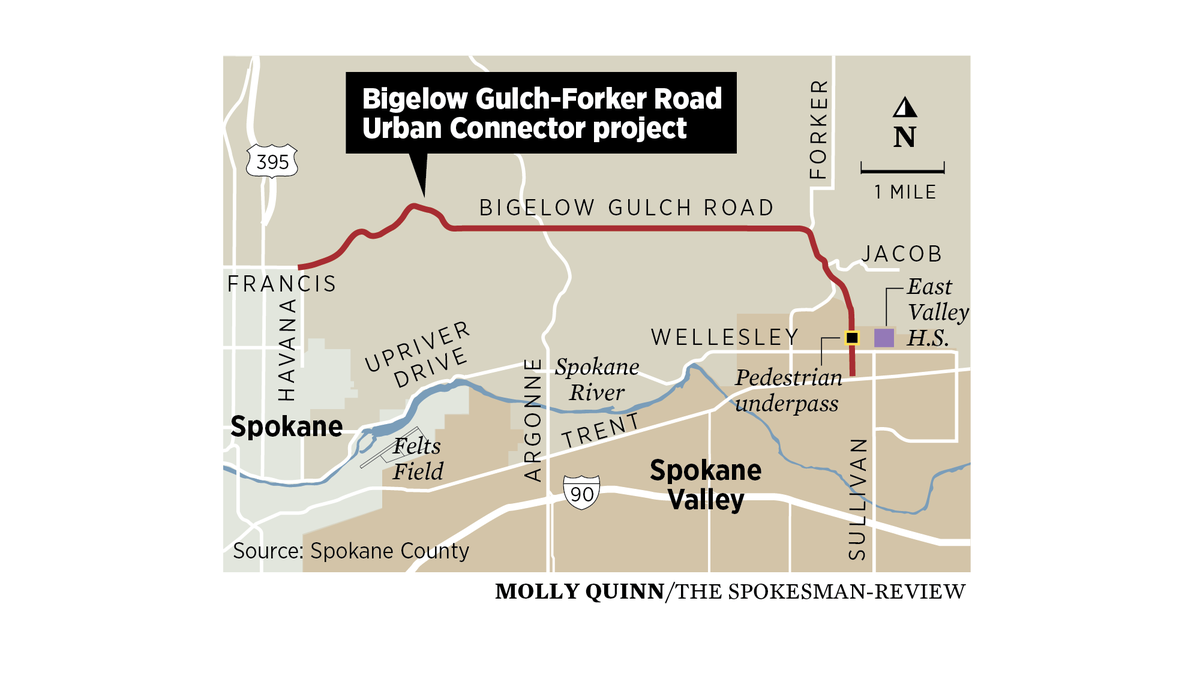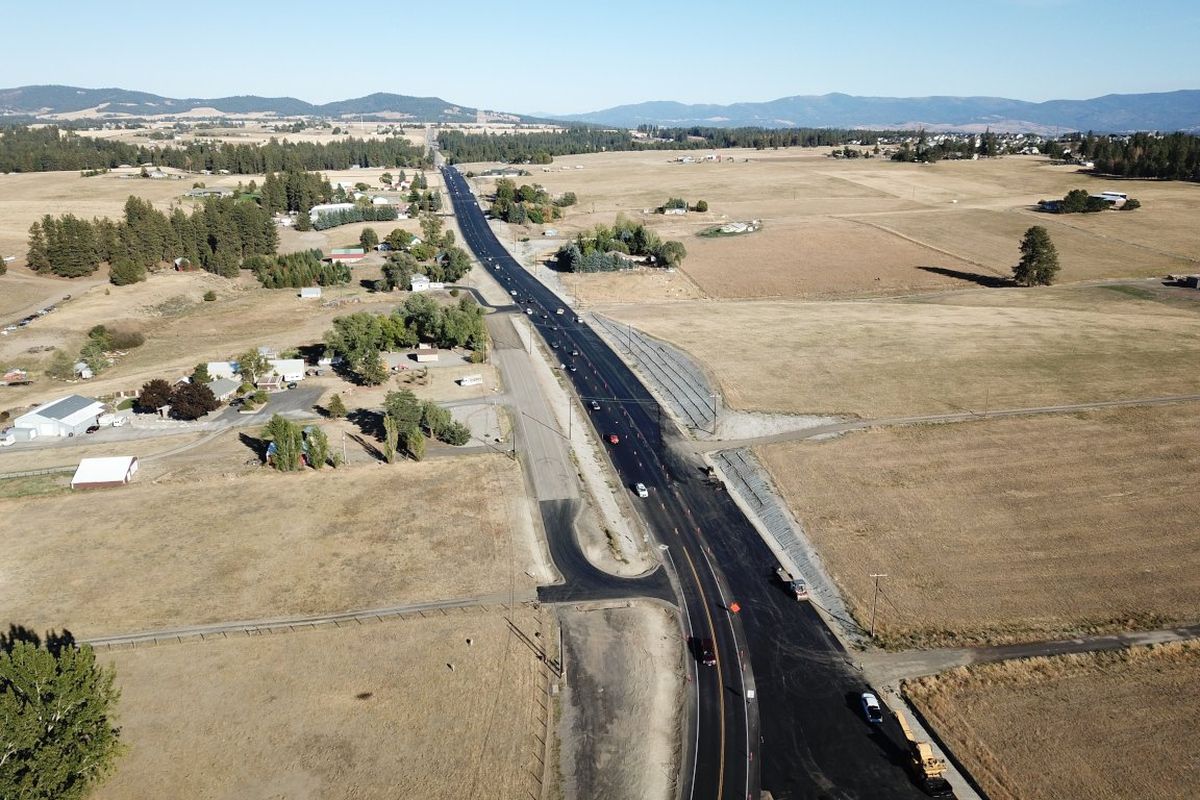Getting There: Land condemnations newest hurdle as Bigelow Gulch project creeps closer to completion
Bigelow Gulch Road Phase 3 is seen looking east in July. Spokane County hopes to have the more than $70 million project done in two years. (COURTESY OF SPOKANE COUNTY)
These 8 miles of road run through beautiful country, winding through woods, looping around grazing horses and cutting through wheat fields.
Some might call the land on either side of the pavement idyllic, but the road itself is anything but.
It’s caused headaches and lawsuits. It’s frustrated residents and broken the hearts of more than half a dozen families whose loved ones died in the past 30 years on the busy, occasionally curvy road .
Spokane County expects to finally finish construction on the Bigelow Gulch-Forker Road Urban Connector in 2023, but there’ll be more trouble before then. On Oct. 26, the Spokane County commissioners voted to initiate condemnation proceedings for five properties along Bigelow Gulch Road, which connects northeast Spokane to Spokane Valley.
The county says it has to condemn portions of the properties – using its eminent domain rights – because it needs land in order to add lanes to, and reduce curves on, Bigelow Gulch Road. The work’s necessary to improve safety and help the road handle more traffic, the county says.
Most of the lane additions and curve reductions are done. The county split the work into nine phases and finished seven of them between 2005 and 2021. That leaves two chunks and $26 million worth of the project to be completed in the next two years.
For some projects, a condemnation fight between the county and landowners would be big news. It’s an emotional process whenever a government tries to seize private property.
But for this project, the condemnations are simply the latest hurdle in a quarter-century saga.
‘This is the scenic route, not the freeway’
The Bigelow Gulch debates began in the mid-1990s. At their heart, they were about change.
Some residents wanted the road, and their lives, to essentially stay the same. For 50 years, Bigelow Gulch had been a two-lane country road used by farmers and ranchers, seemingly a world apart from the hustle and bustle of the city a few miles away.
“This is the scenic route, not the freeway,” Don Hamilton said in a 1996 county meeting about Bigelow Gulch Road. “This should not be screwed with.”
Others said the road needed to be brought into the 21st century. They lobbied for the extra lanes and curve reductions to address issues on what has been one of the county’s most dangerous highways.
At the time, county engineers estimated 13,000 cars traveled the two-lane road every day, more than double what it was built to handle. The road was only going to get busier, they said.
The road was notoriously dangerous, too, with 175 wrecks from 1991 to 1996 alone, and it was a heavily used trucking route.
The county strongly emphasized during the 1996 meeting that all Bigelow Gulch Road modification discussions were preliminary. It’d be another three years before the county committed to the undertaking.
But the seeds of the lane addition and curve reduction idea had been planted. Hypothetical numbers began to appear.
In 1996, the county put a rough $10 million estimate on the project. By 2003, when planning was underway in earnest, the cost had jumped to $25 million. In 2008, it was up to $58 million, and now the overall number is in the $75 million range. The county isn’t on the hook for all of that, thanks to millions in grants, including from the federal government.
Trying to chart costs, traffic numbers
Spokane County Engineer Chad Coles said the scope of the project hasn’t changed much in the past two decades, but there are straightforward reasons for the climbing cost.
Inflation is a major factor, he said. Also the price of right of way has gone up. Construction materials are more expensive now, plus costs for environmental analysis, design and labor have all increased.
Hypothetical traffic numbers began to appear during that early meeting too.
In 1996, county engineers guessed traffic would increase from 13,000 vehicles a day between Market Street and Argonne Road to 20,800 by 2011.
Those estimates were a bit high. Today, 16,000 vehicles travel that eastern half of Bigelow Gulch Road every day.
Coles said looking at the present day traffic counts can be misleading because fewer people are using the road while it’s under construction.
“Neither end is completed,” he explained. “So the through-corridor isn’t as accessible as it will be in the end.”
Traffic on the road is still clearly increasing, Coles said. He noted that back in 2006, 5,300 vehicles used the road every day east of Argonne, which approximately bisects Bigelow Gulch. Projections estimated traffic would grow to 13,700 vehicles a day by 2040. In 2015, the number was up to 7,000 vehicles a day.
Legal battles and condemnations
Shifting cost and traffic estimates probably haven’t slowed the project down, but legal battles have.
The county has been sued over the environmental impacts of the project. And in 2010, the county had its real estate acquisitions shut down after investigations determined county real estate agents violated federal standards. That held up federal grant funds and stalled the project for years.
Then there have been condemnations.
A government condemns a property when it needs the land and the owner refuses to accept the government’s offer.
In this case, Spokane County has to buy dozens of strips of land for right of way along Bigelow Gulch Road’s edges. For some property owners, it’s a lane’s worth of ground. For others, including those living along the curves, it can be multiple acres.
Governments have to follow a set of rules when buying land for right of way. They have to offer fair value. Coles explained that the county has to use appraisers approved by the Department of Transportation. The county’s own assessors aren’t an option.
Many property owners accept the county’s offer, if not at first, then eventually. For instance, the four landowners still refusing to sell their land for the final Bigelow Gulch phase own just five of the 27 properties the county needs for that chunk of the project.
Still, many property owners have balked at the county’s offers. When the two sides can’t agree, the argument goes to the courts and they make their cases.
A 2019 court case showed how much a landowner and the county’s ideas of fair can differ.
Spokane County offered a ranching couple $10,375 for 0.4 acres along the road. Frank and Gloria Bingaman wanted $383,000, emphasizing the land had more value for them due to their cattle operation. The jury awarded the ranchers $132,500.
Alexandria Drake, an attorney with Dunn & Black, represented the Bingamans. Her firm has represented at least nine people along Bigelow Gulch Road during the project.
Drake emphasized the county can’t merely compensate people for the raw value of land with these right of way acquisitions. The cost of the project goes beyond that, because the road is altering the entire area.
“This is a massive project, widening this road to four lanes, and that has had a significant impact on the value of these properties,” Drake said.
Coles said he doesn’t view the lawsuits as a negative. He noted that the courts have determined in each case that the county does need the land. Plus, he said going through the legal system ensures property owners receive fair compensation.
Lawsuits aren’t uncommon for major infrastructure projects. And even though Bigelow Gulch has been an ordeal, an ordeal is expected for a project of this size. You only have to look a few miles west at the North Spokane Corridor to see how slow-moving, astronomically expensive and contentious major infrastructure projects can be.
For all the drama and years of delays, the Bigelow Gulch project is proceeding as planned by some measures. Sure, there was a decadelong gap from 2008 to 2018 when construction was basically on hold and the county didn’t finish a single phase, but the project was long expected to proceed at a snail’s pace.
In the mid-1990s, engineers said they didn’t think they’d break ground before 2020. Engineers foresaw a 15-year project horizon in the early 2000s.
“It doesn’t feel like it should take that long,” Coles said. “But it gets down to process.
“It takes a long time to evaluate the environment. It takes a long time to acquire right of way – whether or not you have go through a court proceeding. Getting all the appraisals. And there’s design work in the midst of that. And there’s more environmental analysis. And then the whole idea of you put all that together and you have to come up with the money.”
Finally, the finish line is in sight.
This summer, the county plans to finish the easternmost, $12.6 million phase of the project, which runs on Forker Road from Progress Road to Wellesley Avenue.
The final phase, which starts near Havana Street and includes the five parcels the county plans to condemn, will be constructed in 2023 for $13.2 million.
Coles said the road is already safer where it’s finished. He said he’s looking forward to the Bigelow Gulch Urban Connector being done.
“It’s a needed improvement for the folks out here in the country; folks in Spokane in general,” Coles said. “It’s a huge benefit; we’re already seeing reductions in crashes and fatalities out there in the parts that we’ve done. I feel good about it.”
What to watch for
57th Avenue from Perry Street to Mt. Vernon Road is open but with reduced speeds due to ongoing construction.
Lane restrictions are in effect on Wellesley Avenue from Railroad Avenue to Murray Road and on Garland Avenue from Molter Road to Murray Road.
Editor’s note: This story has been updated to correct the spelling of Don Hamilton’s name.


